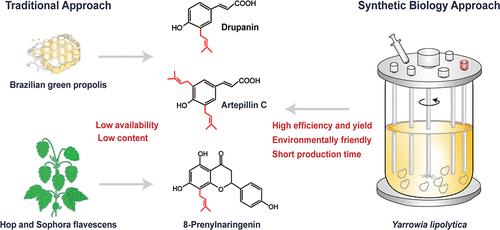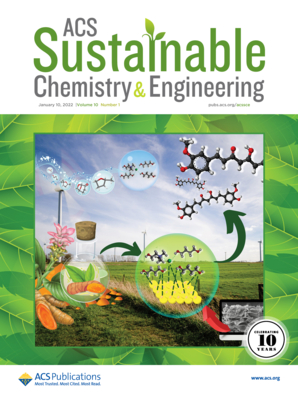Metabolic Engineering and Strain Mating of Yarrowia lipolytica for Sustainable Production of Prenylated Aromatic Compounds
IF 7.1
1区 化学
Q1 CHEMISTRY, MULTIDISCIPLINARY
引用次数: 0
Abstract
Prenylated aromatic compounds possess great pharmaceutical and nutraceutical significance. However, their low abundance in nature hampers their exploitation. Here, we harnessed Yarrowia lipolytica for the production of drupanin, artepillin C, and 8-prenylnaringenin. Specially, we first modularly engineered supply of prenyl donor dimethylallyl diphosphate and aromatic acceptors in parallel in separate haploid strains through engineering prenyltransferases, strengthening the donor or acceptor biosynthesis pathway, tuning the competing pathway, and removing feedback regulation. Then, the mating strategy was developed to mate two haploid strains into diploid strains for de novo biosynthesis of drupanin and artepillin C. The production of drupanin and artepillin C was 52.26 and 7.45 mg/L, respectively, the total production reaching the highest reported titer for de novo synthesis in microbial cell factories. Using a similar approach, we also achieved the biosynthesis of 8-prenylnaringenin in Y. lipolytica for the first time. Our work provides a valuable precedent for the sustainable production of prenylated aromatic natural products, and the mating strategy can extend to synthesis of other similar products.

求助全文
约1分钟内获得全文
求助全文
来源期刊

ACS Sustainable Chemistry & Engineering
CHEMISTRY, MULTIDISCIPLINARY-ENGINEERING, CHEMICAL
CiteScore
13.80
自引率
4.80%
发文量
1470
审稿时长
1.7 months
期刊介绍:
ACS Sustainable Chemistry & Engineering is a prestigious weekly peer-reviewed scientific journal published by the American Chemical Society. Dedicated to advancing the principles of green chemistry and green engineering, it covers a wide array of research topics including green chemistry, green engineering, biomass, alternative energy, and life cycle assessment.
The journal welcomes submissions in various formats, including Letters, Articles, Features, and Perspectives (Reviews), that address the challenges of sustainability in the chemical enterprise and contribute to the advancement of sustainable practices. Join us in shaping the future of sustainable chemistry and engineering.
 求助内容:
求助内容: 应助结果提醒方式:
应助结果提醒方式:


